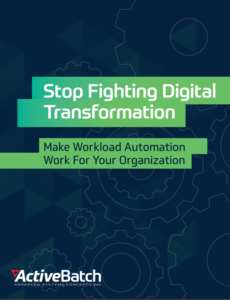Digital Transformation Trends: An IT Perspective
Digital transformation is key to long-term business success. But most digital transformations fail. We take a look at current trends to find out why.

Digital transformation (DX) is accelerating even though only a minority of DX initiatives are successful. We took a look at market-leading research to get a better understanding of why, and what IT teams can do to fix it.
The Importance Of Digital Transformation
Technology is rapidly changing, causing markets and consumer expectations to evolve. In order to adapt, organizations are accelerating their DX efforts, leveraging digital tools to create new processes, services, products, and business models.
The need to transform is clear. A 2020 study by Deloitte Insights found that an organization’s financial success was directly related to the organization’s level of digital maturity. Companies with a high level of digital maturity had three times the net revenue growth of companies with a low digital maturity.
Successful DX helps organizations adapt to new circumstances, making it possible for new processes and services to be quickly delivered. DX provides resilience and is increasingly necessary in order for organizations to maintain a competitive advantage.
According to a recent McKinsey study, 54% of digital revenue is generated by digital-native startups. However, traditional organizations are closing this gap, finding new ways to create new business streams through DX.
Digital Transformation Is Accelerating
2020 has delivered a series of unexpected challenges. From remote work to virtual experiences, organizations have had to quickly roll out new services, upend the traditional workday, and rethink key operations. As a result, 69% of organizations are accelerating their DX initiatives, realizing that short-term survival is linked to long-term success. And quickly adapting to new pressures in 2021 means developing the capability to quickly adapt to future challenges, too.
According to IDC, 30% of organizations will increase innovation and reinvent their business model in order to future-proof their business.
Similar numbers are shown in a number of studies. The Boston Consulting Group found 80% of companies are accelerating their digital transformation, while IDC predicts that, through 2022, 70% of organizations will have “accelerated use of digital technologies, transforming existing business processes to drive customer engagement, employee productivity and business resiliency.”
Not All Digital Transformation Initiatives Succeed
The stakes are high. While DX is seen by many as critical to business success, many DX initiatives do not achieve stated goals. In fact, up to 70% of DX projects will fall short of their objectives. Just as surprising, the rate at which DX initiatives do not meet their goals has been about the same since 2016.
There are several key issues that IT can address in order to help drive DX.
- Over half of all line-of-business users are frustrated by the time it takes IT teams to deliver digital projects.
- Yet, IT teams spend 69% of their time maintaining existing infrastructure and operations and responding to helpdesk requests, instead of working on DX projects.
- Additionally, 89% of IT leaders report that data silos are impeding their organizations’ DX, a number that’s grown 6% over just the last year.
IT is getting busier every year. Systems are becoming more complex, slowing down the time it takes to roll out new processes and slowing down response times. MuleSoft’s 2020 Connectivity Benchmark Report found that 85% of IT teams are hampered by integration challenges that slow down DX. The same report showed that large organizations have over 900 applications on average, 28% of which are integrated.
The next few years will see several technological advancements that further complicate IT’s already-complex environments. This includes new technologies and advancements made possible through 5G, including the internet-of-things (IoT); rapid development of artificial intelligence, blockchain, and emerging technologies to sustain the growth of big data. IT teams must develop the ability to rapidly integrate and orchestrate new tools and technologies into existing systems.
Don’t let IT complexity hamper your digital goals
Get the latest trends and data on what’s driving transformation and how IT teams address these challenges.
Unique Challenges
62% of organizations are tightening their IT budgets. At the same time however, spending on technology across the enterprise is set to rise almost 7%, according to a study done by Gartner. IT teams are getting busier, and do not have the resources necessary to successfully manage increased workloads while maintaining day-to-day operations.
Organizations understand the importance of DX, and that DX initiatives are being used to increase resilience and flexibility while improving customer experiences. Markets and supply chains are being disrupted, and successful DX can help organizations quickly adapt. By 2025, 75% of business leaders “will leverage digital platforms and ecosystem capabilities to adapt their value chains to new markets, industries, and ecosystems,” according to a research report published by IDC.
Addressing The Challenges Of DX
IT’s biggest challenge in the coming year will be balancing an increased project load with demands for innovation, while managing complexity with limited resources. Meanwhile, data and applications will continue to be used in silos, causing integration challenges that hamper real-time data, result in more manual work for IT, and slow down the pace of DX.
In order to manage these challenges, organizations from financial services to healthcare are increasing their use of automation. For example, 81% of IT teams will automate more tasks so that team members will have more time to spend on projects that drive innovation.
It’s not just IT tasks that are being automated, either. According to a Gartner report, the top three DX goals for CIOs are:
- Modernizing legacy systems
- Migrating applications to the cloud
- Automating business processes
The use of automation has been on an upward trend for several years. Automating manual processes helps reduce errors, providing reliability, and enables IT to accomplish more with less by making processes more efficient while minimizing manual interactions — giving IT more time to spend on everything else.
However, the goal of automation has changed as a result of the novel coronavirus. In 2019, the main drivers of automation were cost reduction and performance improvements; in 2021, the main drivers of automation will be business resilience, reduced risk, and faster decision-making, according to research by Bain & Company.
Automation can save IT time and make day-to-day operations more reliable and efficient. But those aren’t the only issues IT is dealing with. Digital ecosystems are increasingly complex, and as we’ve seen, data silos and integration challenges remain two of the biggest hurdles for DX.
Many automation tools are designed for narrow use cases, offering limited functionality for managing end-to-end processes. As a result, many IT teams are using up to eight separate automation tools (including RPA, job schedulers, and custom applications) that are “deployed and utilized in silos, and may be duplicated,” according to Gartner.
In order to drive integration and reduce complexity, IT teams are moving toward extensible automation platforms that provide API adapters. These adapters support low-code automation, enabling IT to rapidly integrate new tools and technologies, such as AI and machine learning to improve data analytics, into existing processes. Or to develop new processes that support innovative services.
MuleSoft’s 2020 Connectivity Benchmark Report found that 60% of IT leaders consider API integrations to be critical to DX, while IT teams with API connectivity are 69% less likely to face significant integration challenges.
With extensible, end-to-end process automation, IT teams can provide the operational resiliency organizations are demanding, while reducing complexity and enabling successful DX.
Ready to see how we make workload automation easy?
Schedule a demo to see how easy it is to build and maintain your jobs in ActiveBatch.








